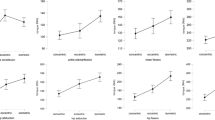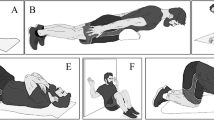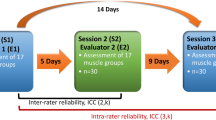Abstract
Purpose
The maximal isometric strength test is widely used in general, athletic, and clinical populations. However, this test has often been used without considering how many trials are needed or appropriate to obtain reliable test scores. Thus, the aim of this study was to examine the maximal isometric strength test in upper and lower body for the purpose of determining the reliability of best isometric strength score and the ideal number of trials for a reliable test score.
Methods
One hundred and twelve healthy adults were assigned to four different groups (elbow flexion with the vertical and horizontal forearm positions, knee flexion, and knee extension). After familiarization, all participants performed three maximal isometric voluntary contractions with the designated muscle group. The reliability of best isometric strength test score was calculated using the intraclass correlation coefficients (ICC) from a one-way ANOVA model. The Spearman–Brown prophecy formula was used to identify the minimum number of trials needed.
Results
The reliability of the best maximal isometric strength test scores out of three trials were high (ICC = 0.92 to 0.98). At least two trials of maximal isometric strength test for knee flexion and one trial for elbow flexion and knee extension would be necessary to achieve an acceptable reliability coefficient of 0.80. In addition, one trial of elbow flexion would be enough for women, but men would need two trials.
Conclusions
Our results suggest that overall, at least two trials would be necessary to test isometric strength in upper and lower body muscles in both sexes.

Similar content being viewed by others
References
Abernethy P, Wilson G, Logan P. Strength and power assessment. Sports Med. 1995;19(6):401–17. https://doi.org/10.2165/00007256-199519060-00004.
American College of Sports Medicine. ACSM’s health-related physical fitness assessment manual. 4th ed. Lippincott: Williams & Wilkins; 2013.
American College of Sports Medicine. ACSM’s guidelines for exercise testing and prescription. 9th ed. Lippincott: Williams & Wilkins; 2014.
Baumgartner TA. Reliability and error of measurement. In: Wood TM, Zhu W, editors. Measurement theory and practice in kinesiology. 1st ed. Champaign: Human Kinetics; 2006. p. 27–52.
Bellar D, Marcus L, Judge LW. Validation and reliability of a novel test of upper body isometric strength. J Hum Kinet. 2015;47(1):189–95. https://doi.org/10.1515/hukin-2015-0074.
Brown W. Some experimental results in the correlation of mental abilities 1. Br J Psychol 1904–1920. 1910;3(3):296–322.
Brzycki M. Strength testing—predicting a one-rep max from reps-to-fatigue. J Phys Educ Recreat Dance. 1993;64(1):88–90.
Colombo R, Mazzini L, Mora G, Parenzan R, Creola G, Pirali I, Minuco G. Measurement of isometric muscle strength: a reproducibility study of maximal voluntary contraction in normal subjects and amyotrophic lateral sclerosis patients. Med Eng Phys. 2000;22(3):167–74.
Coombs R, Garbutt G. Developments in the use of the hamstring/quadriceps ratio for the assessment of muscle balance. J Sports Sci Med. 2002;1(3):56.
Danneskiold-Samsøe B, Bartels EM, Bülow PM, Lund H, Stockmarr A, Holm CC, Wätjen I, Appleyard M, Bliddal H. Isokinetic and isometric muscle strength in a healthy population with special reference to age and gender. Acta Physiol. 2009;197(Suppl. 673):1–68.
Enoka RM. Eccentric contractions require unique activation strategies by the nervous system. J Appl Physiol. 1996;81(6):2339–46.
Enoka RM, Duchateau J. Muscle fatigue: what, why and how it influences muscle function. J Physiol. 2008;586(1):11–23.
Griffith EE, Yoon T, Hunter SK. Age and load compliance alter time to task failure for a submaximal fatiguing contraction with the lower leg. J Appl Physiol. 2010;108(6):1510–9.
Hunter SK. Sex differences in human fatigability: mechanisms and insight to physiological responses. Acta Physiol. 2014;210(4):768–89.
Hunter SK. The relevance of sex differences in performance fatigability. Med Sci Sports Exerc. 2016;48(11):2247.
Jaric S. Muscle strength testing. Sports Med. 2002;32(10):615–31.
Knapik JJ, Vogel JA, Wright JE. Measurement of isometric strength in an upright pull at 38 cm (No. USARIEM-T-3/81). US Army Research Institute of Environmental Medicine, Natick, MA; 1981.
Levoska S, Keinänen-Kiukanniemi S, Hämäläinen O, Jäms T, Vanharanta H. Reliability of a simple method of measuring isometric neck muscle force. Clin Biomech. 1992;7(1):33–7.
Loftice J, Fleisig GS, Zheng N, Andrews JR. Biomechanics of the elbow in sports. Clin Sports Med. 2004;23(4):519–30.
Malliou P, Ispirlidis I, Beneka A, Taxildaris K, Godolias G. Vertical jump and knee extensors isokinetic performance in professional soccer players related to the phase of the training period. Isokinet Exerc Sci. 2003;11(3):165–9.
Marcora S, Miller MK. The effect of knee angle on the external validity of isometric measures of lower body neuromuscular function. J Sports Sci. 2000;18(5):313–9.
Morrison JB. The mechanics of the knee joint in relation to normal walking. J Biomech. 1970;3(1):51–61.
Morrow JR Jr, Mood D, Disch J, Kang M. Measurement and evaluation in human performance. 5th ed. Champaign: Human Kinetics; 2015.
Nyberg A, Saey D, Martin M, Maltais F. Test–re-test reliability of quadriceps muscle strength measures in people with more severe chronic obstructive pulmonary disease. J Rehabil Med. 2018;50(8):759–64.
Sardelli M, Tashjian RZ, MacWilliams BA. Functional elbow range of motion for contemporary tasks. J Bone Jt Surg. 2011;93(5):471–7.
St Clair Gibson A, Lambert MI, Durandt JJ, Scales N, Noakes TD. Quadriceps and hamstrings peak torque ratio changes in persons with chronic anterior cruciate ligament deficiency. J Orthop Sports Phys Ther. 2000;30(7):418–27.
The U.S. Department of Health and Human Services. Physical Activity Guidelines for Americans. 2nd ed. Washington: The U.S. Department of Health and Human Services; 2018.
Webber SC, Porter MM. Reliability of ankle isometric, isotonic, and isokinetic strength and power testing in older women. Phys Ther. 2010;90(8):1165–75.
Acknowledgements
The authors would like to thank all the participants who took time out of their schedules to help with these projects.
Author information
Authors and Affiliations
Corresponding author
Rights and permissions
About this article
Cite this article
Jeon, S., Miller, W.M., Kang, M. et al. The Minimum Number of Attempts for a Reliable Isometric Strength Test Score. J. of SCI. IN SPORT AND EXERCISE 2, 89–95 (2020). https://doi.org/10.1007/s42978-019-00035-3
Received:
Accepted:
Published:
Issue Date:
DOI: https://doi.org/10.1007/s42978-019-00035-3




